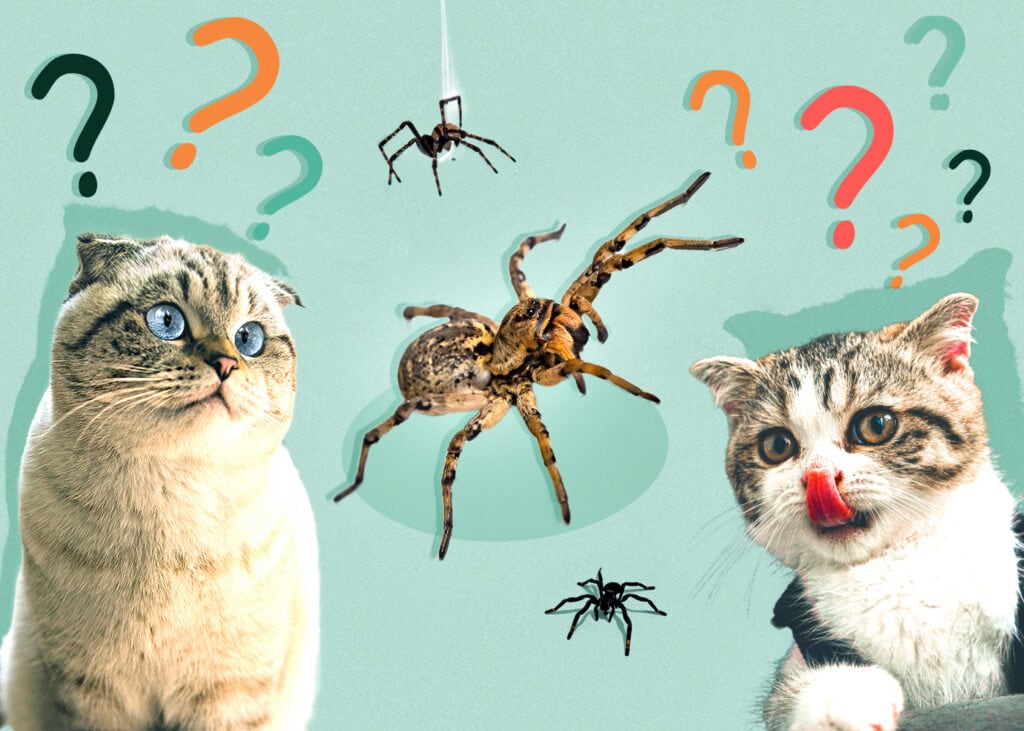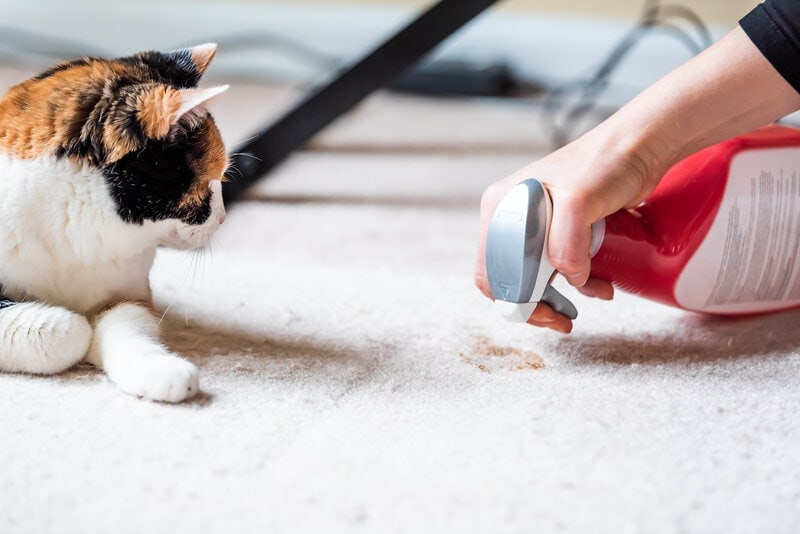Can Cats Eat Spiders? Nutrition Facts & Safety Guide
Updated on

Despite the many benefits spiders provide, these eight-legged invertebrates are often a source of fear and terror for many people. Cats may not be able to share their opinions on spiders but, thanks to their hunting instincts, they may very well try to eat them! So, is it okay to let your cat eat spiders?
Most of the time, eating spiders won’t cause problems for your cat. However, some cats may develop digestive issues. More serious medical issues could occur if your cat is bitten by a spider, especially a venomous species.
In this article, we’ll talk about why your cat might be chasing and eating spiders and other bugs and help you learn to identify the two most common venomous spiders in the United States. We’ll also let you know what signs to look out for if your cat is bitten by a spider and how to keep your cat entertained so they hopefully leave spiders alone.
Eww! Why Would My Cat Eat A Spider Anyway?
Don’t worry, your cat most likely isn’t snacking on spiders because you aren’t feeding them well enough. While cats are carnivores who need a diet high in protein, spiders and insects don’t provide much of this essential nutrient, especially if only eaten occasionally. As long as you feed your cat a quality, nutritionally-balanced diet, you shouldn’t need to worry.
So, if your cat isn’t eating spiders because they’re hungry, why are they snacking on eight-legged creatures? Well, because cats are natural-born predators, your cat is probably just following their hunting instincts. Stalking and eating bugs and spiders is one of the few ways your indoor cat can satisfy their urge to hunt.
Spiders are fast-moving and cats are hard-wired to chase things that move. Hunting spiders can also be a fun and stimulating pastime for otherwise bored house cats.

Will Eating Spiders Make Your Cat Sick?
Most of the time, eating spiders or bugs won’t make your cat sick. Occasionally, they may cause digestive issues like vomiting or diarrhea, especially if your cat has a history of a sensitive stomach. Usually, these signs will resolve on their own in a day or two. If not, you should call your veterinarian.
If you have your house treated with pest-control products, be sure to choose those safe to use around pets. While eating a dead pest killed by poison probably won’t harm your cat, coming into contact with unsafe products could.
When Spiders Attack: What To Watch For
Despite the major size difference between your cat and a spider, the smaller creatures may be little, but their bite can be fierce. Even a bite from a non-venomous spider could cause an allergic reaction in your cat. However, the most serious issues are caused by venomous spider bites.
In the US, the two groups responsible for the most dangerous spider bites are the widow (Latrodectus sp.) and the recluse (Loxosceles sp.) spiders. There are five widow species and 11 native recluse species in North America.
Black Widow Spiders
Black widows are found throughout North America, except in Alaska. The females, who are most commonly seen, are about 1 inch long, shiny black with a distinctive red hourglass on their abdomen.
- Tremors
- Muscle and abdominal pain
- Trouble walking
- Vomiting
- Diarrhea
- Drooling
In severe cases, black widow spider bites can cause blood pressure changes, paralysis, and death.
If you suspect your cat may have been bitten by a black widow spider, contact your veterinarian right away. Treatment may include administering an antivenin, anti-seizure medications, pain medications, and other supportive care.

Brown Recluse Spiders
Brown recluse spiders are found in the Southern, Midwestern, and sometimes Southwestern regions
of the United States. They are about ½-inch long spiders, brown, with a darker violin shape on their abdomen.
- Severe skin wounds
- Vomiting
- Fever
- Lethargy
- Bruising
In severe cases, brown recluse bites may lead to kidney and liver damage or bleeding disorders. If you suspect your cat was bitten by a brown recluse, contact a veterinarian immediately. There is no antivenom for a brown recluse bite. Treatment generally depends on the types of symptoms noted.

How To Keep Your Cat Safe
Because it can be hard to identify the type of spider you catch your cat trying to eat, it’s a good idea to discourage them from playing with them at all. Though this is easier said than done, here are a few tips.
First, keep your cat indoors and out of areas where venomous spiders are known to live, such as basements, sheds, garages, and similar locations. Should you spot your cat playing with a spider, remove the kitty from the area and deal with the spider as you see fit.
If your cat is chasing and eating spiders out of boredom, make sure you’re spending plenty of quality time playing with your feline friend. Also, make sure your cat has safe toys that allow them to exercise and satisfy their natural urge to hunt for prey, such as this robotic bug. If your cat spends a lot of time alone, consider hiring a pet sitter to come play with your cat during the day.
Now that you know what you can safely feed your cat, it’s just as important to find a bowl that supports their health and well-being. With whisker-friendly bowls and a wide tray to catch any spills, our Hepper NomNom Cat Bowl is our favorite option.
Conclusion
Spiders may give you creepy crawlies, but your cat will likely find them fascinating and occasionally delicious. While eating spiders is unlikely to cause your cat harm outside of the odd upset stomach, the real trouble begins when they encounter a spider who bites back. Venomous spider bites are painful, dangerous, and sometimes deadly. To avoid bites, encourage your cat to play with something safer than a live spider and know what to do in the event your cat is bitten by a spider or an insect.
Featured Image Credit: Ben_Kerckx, Pixabay













